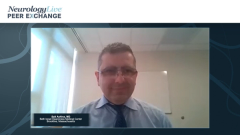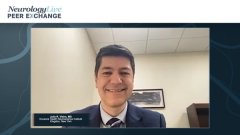
Assessing Treatment Response and Efficacy for Migraine Therapy
Julio R. Vieira, MD, leads a discussion on the importance of follow-up visits for patients with migraine and considerations for switching therapies.
Episodes in this series

Jessica Ailani, MD:Let’s move to the last part of this interesting discussion about prevention and acute treatment, which is how do we even know if anything we do is working? We talked already about headache calendars. Let’s put that idea aside. We talked about patient-reported outcomes but let’s focus on follow-up and changing treatment. Julio, when do you tell the patient to come in for follow-up after you start a new prescription? And when do you decide to change their treatment, whether it’s acute treatment or prevention?
Julio R. Vieira, MD: The follow-up visits frequency, for me, at least it varies. If I see, like you mentioned, a naive patient that’s coming for the first time, I try to bring them in at least approximately 6 weeks after the first consultation. Sometimes the medications are not going to be in full effect yet, but then we have the process of hand holding the patients really appreciate, and they want to touch base and see how things are going. And it also depends on the baseline headache frequency. If you have somebody that has episodic migraine with 1 episode here and there, if you bring them too quickly, you’re not going to be able to see any changes. And if you have those who have tons of headaches, tons of migraines in a month, and you start on the therapy sometimes pretty quickly, you’re going to see if that’s going to be effective or not. But then we can evaluate the satisfaction with the current therapies that the patients also have compliance, tolerability, effectiveness. And to the point that you brought, which is important, is whenever the patient brings in some suggestion of a therapy, I always try to go for that 1 if the profile of a patient, if it’s going to make sense. Because when it comes from their decision, going back to the data that we provided before, the patients are not happy and end up abandoning their treatment. That is a very good reason to continue that. And sometimes to change treatments or not, sometimes it takes approximately—it depends on the medication that we’re using, right? Traditionally, the old-school medications that we borrowed to treat other conditions like topiramate, propranolol, the antidepressants, those medications take a while to work. If a patient is in the beginning of their therapy, we try to bring them in, to evaluate therapy approximately 3 months later in order to potentially switch or not. Unless if the patient is having severe adverse effects or they cannot tolerate a particular medication, those are the cases that we would consider to do it earlier, and sometimes try to do it right away to address the patient and not lose their trust. Because sometimes patients come in for a consultation, they have a medication and they disappear and they come back a year later and you’re like, “What happened? ‘Oh, I took the medication. I didn’t like it and I disappeared.’” And then we go back to reevaluate and sometimes you must recreate therapy and try to engage them a lot more to try to have a better compliance.
Jessica Ailani, MD: I find keeping the patient engaged it can be sometimes easy, but sometimes it can be difficult. While we might set a certain follow-up based on when we have availability too, a lot of the times I encourage our patients. We have a full team. We work with our nurse practitioners. If I feel like they’re not doing well the first visit, I might set up 2 visits the first in 6 weeks to follow up with the nurse practitioner and then also schedule 3 months to see me. I encourage if the treatment is not working or they’re having side effects to send us a portal message. I absolutely adore these portals for the reason. Not because I want to answer very long messages, but we use it to, “Oh, you need to come in sooner.” You message us. We document the need for sooner visit. And then we pull them in for a quicker follow-up instead of them getting lost like you were saying, which used to happen all the time in the past. They try to call an academic center. They end up on hold forever. Then they give up understandably. And the last thing we want is to get them thinking that nobody really cares if they’re not doing well, and they disappear. That was a great summary on how do we follow up on any of these new treatments that we started and make the decision to change treatment if they’re not satisfied, it’s not working for them. They hear about a different treatment, and they feel like they might do better on a different treatment option to have the conversation, if it’s the right treatment for them or not and consider the change if they’re not meeting their treatment goals.
Andrew C. Charles, MD: I would just chime in and say one other objective piece of evidence that preventive therapies are working is acute medication use. And that’s an easy way to track. It’s not entirely reliable, but certainly, if you see somebody’s acute medication use falling off by 75%, that’s in many cases an indication that they are having a nice response to the preventive therapy. That’s another one. I would also just say to this point of these portals, one thing that we have to do a better job with is enabling patient rendered information to get into the medical record without necessarily us having to be a middle person. And that direct entry of data like headache days or acute medication use, we can obviously capture based on prescriptions. But something more like acute medication use where we can really track, not without necessarily having them come in, their prospective experience with the different therapies that we’re initiating.
Jessica Ailani, MD:There are some application programs that have been worked on where they link to electronic medical records and the patients can do the app at home and it links to the record. My hope is that systems appreciate the importance of these programs and purchase them to link with the electronic medical records. Not only does that save you energy upfront, but the wealth of information provided and the amount of care. The quality of care improves drastically when you have that actual data, not the “I think I’m doing OK,” or the retrospective recall from the patient, “I’m doing terrible,” and they even bring you a calendar. And you’re like, “You’ve been doing really well. You’re just doing poorly today and yesterday.” And they’re like, “Well, I feel terrible.” I’m like, “Of course you do right now. You’re having a migraine, but you brought me data that you had a tremendous improvement, but clearly, can only feel what you’re feeling right now.” I agree with you, Andy. It’s a great point. I wanted to thank you all for joining us for this segment where we’ve been discussing treatment options in migraine, how to use them, when to pull out new treatments are wonderful consensus statements that can help you in the audience and your patients really try to navigate the authorization system to get new treatment options for your patients.
Transcript Edited for Clarity
Newsletter
Keep your finger on the pulse of neurology—subscribe to NeurologyLive for expert interviews, new data, and breakthrough treatment updates.































